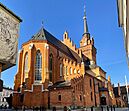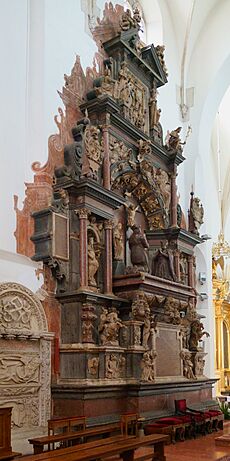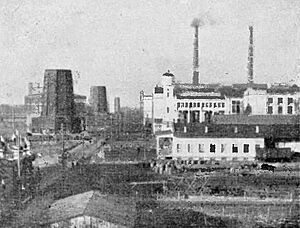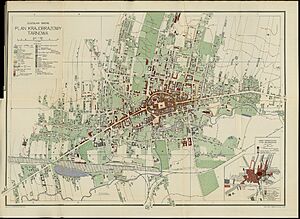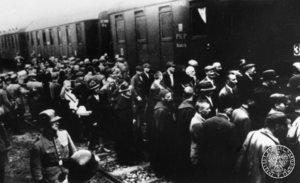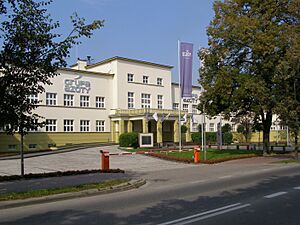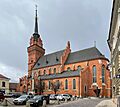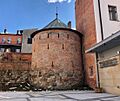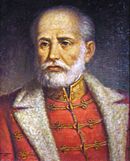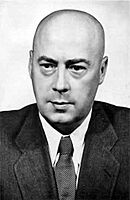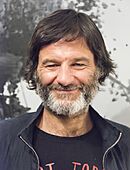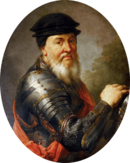Tarnów facts for kids
Quick facts for kids
Tarnów
|
|||
|---|---|---|---|
|
|||
|
|||
| Country | |||
| Voivodeship | |||
| County | City-County | ||
| City rights | 7 March 1330 | ||
| Area | |||
| • City | 72.4 km2 (28.0 sq mi) | ||
| Population | |||
| • City | 105,922 |
||
| • Metro | 269,000 | ||
| Time zone | UTC+1 (CET) | ||
| • Summer (DST) | UTC+2 (CEST) | ||
| Postal code |
33–100 to 33–110
|
||
| Area code(s) | +48 14 | ||
| Car plates | KT | ||
| Website | http://www.tarnow.pl | ||
| Historical population | ||
|---|---|---|
| Year | Pop. | ±% |
| 1950 | 37,405 | — |
| 1960 | 70,835 | +89.4% |
| 1970 | 85,929 | +21.3% |
| 1980 | 105,109 | +22.3% |
| 1990 | 121,216 | +15.3% |
| 2000 | 120,822 | −0.3% |
| 2010 | 114,635 | −5.1% |
| 2020 | 107,498 | −6.2% |
| source | ||
Tarnów is a city in southeastern Poland. It has about 105,922 people living there. The larger area around the city has about 269,000 people. Tarnów is located in the Lesser Poland Voivodeship.
The city is an important train hub. It connects major cities like Lviv and Kraków. There are also train lines to the Slovak border. Tarnów is famous for its old Polish buildings. These buildings show influences from different cultures. People from Jewish, German, and Austrian backgrounds once lived here.
The Old Town still has buildings from the 1500s. It also has parts of old defensive walls. Tarnów is known as the warmest city in Poland. It has the highest average yearly temperature in the country.
Big companies like Grupa Azoty (chemicals) and ZMT (defense) are based here. The city is divided into 16 areas called districts. It is also part of the Association of Polish Cities.
Contents
The Name of Tarnów
The name "Tarnów" was first written down in 1105 as Tharnow. Over time, it changed to Tarnowo and then Tarnów. This name is common in many Slavic countries. You can find similar names in places like eastern Germany, Hungary, and northern Greece.
The name Tarnów comes from an old Slavic word. This word is trn or tarn. It means "thorn" or an area covered with thorny plants.
Tarnów's History
Around the mid-800s, a Slavic settlement was built near Tarnów. It was on St. Martin Mount, about 2.5 kilometers from today's city center. This settlement was likely built by the Vistulans. It was quite large, almost 16 hectares. A rampart surrounded it.
This early settlement was probably destroyed in the 1030s or 1050s. This might have happened during a rebellion against Christianity. It could also have been during a Czech invasion. In the mid-1000s, a new settlement was built by the Biała river. This land belonged to the king. Later, it was given to the Tyniec Benedictine Abbey. The name Tarnów was first mentioned in a document in 1124.
The first clear mention of Tarnów is from 1309. It talks about a woman from the settlement. In 1327, a knight named Spicymir bought a village called Tarnów Wielki. Three years later, he started his own private town there. On March 7, 1330, King Władysław I the Elbow-high gave Tarnów city rights. This was based on Magdeburg rights. A year later, a castle was finished on St. Martin Hill. Its ruins can still be seen today.
Tarnów stayed with the Leliwa family for a long time. The Tarnowski family came from this family in the 1400s. Many German settlers moved here in the 1300s. They came from Kraków and Nowy Sącz. Later, in the 1600s, many Scottish immigrants arrived.
The town grew a lot during the Polish Golden Age. This was when Hetman Jan Tarnowski (1488–1561) owned it. In the mid-1500s, about 1,200 people lived here. There were 200 houses inside the town's defensive wall. The wall itself was built in the mid-1400s and made bigger in the early 1500s. By 1467, the town had water and sewage systems. Large tanks for drinking water were in the main market square. In the 1500s, Tarnów had a school, a synagogue, and churches. It also had many different guilds (groups of skilled workers).
Polish–Lithuanian Commonwealth Era
After Jan Tarnowski died in 1561, an Italian artist named Jan Maria Padovano started building a beautiful Renaissance headstone. This monument for Hetman Tarnowski is almost 14 meters tall. It is in St. Anne Chapel, inside the Tarnów Cathedral. Padovano finished his work in 1573. He also designed the Renaissance town hall. He oversaw its changes in the 1560s. At that time, 28 niches in the town hall held portraits of the Tarnowski family.
In 1570, Tarnów became property of the Ostrogski family. This happened when Zofia Tarnowska married Prince Konstanty Wasyl Ostrogski. After Konstanty died in 1588, the town was owned by different families. This slowed its growth. Tarnów was part of the Sandomierz Voivodeship until Poland was divided. In October 1655, the town was badly damaged during the Swedish invasion of Poland. Its population dropped from 2,000 to 768 people. In 1723, the Sanguszko family bought the town.
Under the Habsburg Empire
After the first division of Poland in 1772, Tarnów became part of the Habsburg Empire. It stayed in Austrian Galicia until 1918. Austrian rule changed the town. It was no longer private property. It became the main city of a county. It also became the seat of the Roman Catholic Diocese of Tarnów in 1783.
On March 14, 1794, Józef Bem was born in Tarnów. In the 1830s, Tarnów became a center for Polish secret groups. These groups wanted to start an uprising. But their plans failed in 1846. At that time, local peasants started attacking the nobility. This event was called the Galician slaughter. It began on February 18, 1846. Peasant groups attacked manor houses in three counties, including Tarnów.
Tarnów grew quickly in the second half of the 1800s. This was because of new railway lines. In 1852, the town got a train connection to Kraków. By 1870, its population was 21,779. In 1878, gas lighting was installed. Three years later, the first daily newspaper started. In 1888, the Diocese Museum was founded. By 1910, Tarnów had modern waterworks, a power plant, and a new main train station.
The city remained a place for Polish secret activities. About 20% of all members of the Polish Legions in World War I came from Tarnów. On November 10, 1914, the Russian Imperial Army took over Tarnów. They stayed until May 6, 1915. During this time, Tarnów was shelled by German-Austrian artillery. This caused damage to some parts of the city.
Second Polish Republic Era
Tarnów was one of the first Polish cities to be freed after World War I. Polish Legions liberated the city on October 30–31, 1918. In the Second Polish Republic, Tarnów was part of the Kraków Voivodeship. Many important people came from Tarnów, like Franciszek Latinik and Wincenty Witos.
In early 1927, a large chemical plant began to be built. It was in the village of Świerczków, which is now part of Mościce, a district of Tarnów. Before World War II, Tarnów had 40,000 people. Almost half of them were Jewish. On August 28, 1939, a German saboteur caused a bomb attack at the Tarnów train station. This killed 20 people and wounded 35. This happened just four days before Nazi Germany invaded Poland and World War II began.
World War II and Its Impact
German forces took over Tarnów on September 7, 1939. Under German rule, Tarnów became part of the General Government area. In September 1939, special German units entered the city. They committed terrible acts against Poles. Poles from western Poland were sent to Tarnów in freight trains.
On June 14, 1940, the first large group of Polish political prisoners left Tarnów station. They were sent to Auschwitz concentration camp. There were 728 prisoners, including at least 67 underage boys. During the entire German occupation of Poland, Tarnów was a key center for the Armia Krajowa (AK). This was a Polish resistance group. In mid-1944, the AK's 16th Infantry Regiment "Barbara" took part in Operation Tempest.
After the Warsaw Uprising in October 1944, the Germans sent 3,000 people from Warsaw to Tarnów. These were mostly old, sick people and women with children. The German army left Tarnów on January 18, 1945. The city was then taken by the Red Army and given back to Poland.
After the War
A few months later, the Museum of Tarnów Land opened. Tarnów began to rebuild after the war. In 1957, the State Theatre of Ludwik Solski opened. From 1975 to 1998, Tarnów was the capital of the Tarnów Voivodeship.
The Jewish Community of Tarnów
Before World War II, about 25,000 Jewish people lived in Tarnów. They had been in the town since the mid-1400s. Jewish people made up about half of the town's population. Many Jewish businesses in Tarnów made clothes and hats. The Jewish community had many different beliefs and groups.
After the Germans took over the city in September 1939, they began to persecute Jewish people. German units burned most of the city's synagogues on September 9. They forced Jewish people to work. Many Jewish people from Tarnów fled to the east. But many Jewish refugees from other parts of Poland came to Tarnów. In early November, the Germans ordered a Jewish council (Judenrat) to be set up. This council had to pass on German orders to the Jewish community. They also had to collect taxes and provide workers for forced labor.
Life became very hard for Jewish people in Tarnów during 1941. The Germans demanded a large fine from the community. Jewish people had to hand over their valuable items. More and more often, people were rounded up for forced labor. Killings also became more common.
Deportations from Tarnów began in June 1942. About 13,500 Jewish people were sent to the Belzec extermination camp. Many Poles were put in prison by the Germans for helping Jewish people. Some were sent to Auschwitz and other camps, where some died.
After the June deportations, the Germans forced the remaining Jewish people into the new Tarnów Ghetto. This ghetto was surrounded by a tall wooden fence. Life in the ghetto was terrible. There was little food, poor sanitation, and forced labor in factories. In September 1942, the Germans ordered everyone in the ghetto to gather in Targowica Square. There, they were "selected." Those considered "non-essential" were sent to Belzec. About 8,000 people were deported. More deportations from Tarnów to extermination camps happened later. A group of 2,500 was sent in November 1942.
Resistance During the Holocaust
During the 1942 deportations, some Jewish people in Tarnów formed a resistance movement. Many of these leaders were young Zionists. They were part of the Hashomer Hatzair youth movement. Many who left the ghetto to fight in the forests were killed by German SS units. Others tried to find ways to escape to Hungary, but it was very difficult.
The Germans decided to destroy the Tarnów ghetto in September 1943. The remaining 10,000 Jewish people were deported. 7,000 were sent to Auschwitz and 3,000 to the Plaszow concentration camp. By late 1943, Tarnów was declared "free of Jews." By the end of the war, most Jewish people from Tarnów had been killed. About 700 Jewish people returned in 1945, but many soon left the city. Many moved to Israel.
Tarnów's Geography
Tarnów is located at the foot of the Carpathian mountains. The Dunajec and Biała rivers flow through it. The city covers an area of 72.4 square kilometers. It is divided into sixteen districts, called osiedla.
A few kilometers west of the city is the Mościce district. This area was built in the late 1920s. It includes a large chemical plant. To the southeast is Saint Martin's Peak. The Mościce district was named after the President of Poland, Ignacy Mościcki.
Climate in Tarnów
Tarnów has a mild climate. It is one of the warmest cities in Poland. The average temperature in January is -0.4°C. In July, the average temperature is 19.8°C. People say Tarnów has the longest summer in Poland. It lasts from mid-May to mid-September, which is over 118 days.
| Climate data for Tarnów (1991–2020 normals, extremes 1951–present) | |||||||||||||
|---|---|---|---|---|---|---|---|---|---|---|---|---|---|
| Month | Jan | Feb | Mar | Apr | May | Jun | Jul | Aug | Sep | Oct | Nov | Dec | Year |
| Record high °C (°F) | 15.5 (59.9) |
20.6 (69.1) |
24.8 (76.6) |
31.1 (88.0) |
33.4 (92.1) |
35.5 (95.9) |
37.7 (99.9) |
37.9 (100.2) |
36.8 (98.2) |
27.6 (81.7) |
22.1 (71.8) |
19.5 (67.1) |
37.9 (100.2) |
| Mean daily maximum °C (°F) | 2.1 (35.8) |
4.0 (39.2) |
8.8 (47.8) |
15.5 (59.9) |
20.4 (68.7) |
23.7 (74.7) |
25.6 (78.1) |
25.5 (77.9) |
19.9 (67.8) |
14.4 (57.9) |
8.3 (46.9) |
3.2 (37.8) |
14.3 (57.7) |
| Daily mean °C (°F) | −1.1 (30.0) |
0.2 (32.4) |
3.9 (39.0) |
9.7 (49.5) |
14.4 (57.9) |
17.9 (64.2) |
19.6 (67.3) |
19.1 (66.4) |
14.1 (57.4) |
9.4 (48.9) |
4.7 (40.5) |
0.3 (32.5) |
9.4 (48.9) |
| Mean daily minimum °C (°F) | −4.0 (24.8) |
−3.0 (26.6) |
−0.1 (31.8) |
4.3 (39.7) |
8.7 (47.7) |
12.2 (54.0) |
13.9 (57.0) |
13.4 (56.1) |
9.3 (48.7) |
5.4 (41.7) |
1.8 (35.2) |
−2.5 (27.5) |
5.0 (41.0) |
| Record low °C (°F) | −30.3 (−22.5) |
−28.2 (−18.8) |
−24.6 (−12.3) |
−7.5 (18.5) |
−3.2 (26.2) |
0.2 (32.4) |
5.5 (41.9) |
2.9 (37.2) |
−3.0 (26.6) |
−7.8 (18.0) |
−15.8 (3.6) |
−27.6 (−17.7) |
−30.3 (−22.5) |
| Average precipitation mm (inches) | 34.7 (1.37) |
33.7 (1.33) |
38.5 (1.52) |
53.2 (2.09) |
92.1 (3.63) |
92.8 (3.65) |
107.2 (4.22) |
66.4 (2.61) |
71.8 (2.83) |
51.5 (2.03) |
38.0 (1.50) |
33.2 (1.31) |
713.2 (28.08) |
| Average extreme snow depth cm (inches) | 9.2 (3.6) |
11.2 (4.4) |
6.1 (2.4) |
2.3 (0.9) |
0.0 (0.0) |
0.0 (0.0) |
0.0 (0.0) |
0.0 (0.0) |
0.0 (0.0) |
0.5 (0.2) |
4.3 (1.7) |
5.7 (2.2) |
11.2 (4.4) |
| Average precipitation days (≥ 0.1 mm) | 17.07 | 14.66 | 14.77 | 13.37 | 15.03 | 14.57 | 14.97 | 11.87 | 12.47 | 13.17 | 13.21 | 15.08 | 170.22 |
| Average snowy days (≥ 0 cm) | 18.6 | 16.7 | 7.3 | 1.1 | 0.0 | 0.0 | 0.0 | 0.0 | 0.0 | 0.4 | 5.3 | 12.7 | 62.1 |
| Average relative humidity (%) | 82.2 | 79.1 | 73.6 | 68.2 | 70.7 | 72.1 | 73.2 | 73.9 | 78.9 | 80.9 | 82.9 | 83.2 | 76.6 |
| Mean monthly sunshine hours | 51.3 | 69.9 | 120.1 | 176.2 | 222.0 | 230.0 | 240.3 | 235.6 | 155.0 | 115.9 | 60.9 | 45.6 | 1,722.7 |
| Source 1: Institute of Meteorology and Water Management | |||||||||||||
| Source 2: Meteomodel.pl (records, relative humidity 1991–2020) | |||||||||||||
Tarnów's Economy
Tarnów is an important center for business and industry. The city has chemical plants like Zakłady Azotowe w Tarnowie-Mościcach S.A. This is part of Grupa Azoty, Poland's biggest chemical company. Other companies make paints, packaging, and food products. There are also companies that make building materials and textiles.
Zakłady Mechaniczne Tarnów is another important company here. It works in the defence industry. They make handguns, assault rifles, sniper rifles, and anti-air guns. This company is part of the state-controlled Bumar Corporation. Tarnów is also a key center for the natural gas industry.
You can find major shopping malls in Tarnów, like Gemini Park Tarnów and Galeria Tarnovia.
Getting Around Tarnów
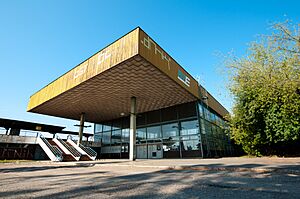
Tarnów is a major hub for roads and trains. It sits where two main roads meet. These are the ![]() motorway (part of European route E40) and National Road No. 73. This road goes from Kielce to Jasło.
motorway (part of European route E40) and National Road No. 73. This road goes from Kielce to Jasło.
The city is also a train junction with four lines. Three main electric lines go west to Kraków, east to Dębica, and south to Nowy Sącz. There is also a local line to Szczucin. Train transport in Tarnów started in 1856. The main train station building was finished in 1906. Since 2010, the Tarnów station has a modern art gallery. This is the only such gallery in a train station in Poland. Tarnów also has three other stations: Tarnów Mościce, Tarnów Północny, and Tarnów Klikowa. The last two are not currently in use.
The city's public transport has 29 bus routes. These buses make it easy to travel to all parts of the city. From 1911 to 1942, Tarnów had a tram line. It was 2.5 kilometers long, but now buses have replaced it.
Things to See in Tarnów
Tarnów is an important place for tourists, culture, and business in Lesser Poland Voivodeship. The old town of Tarnów is often called the "pearl of the Polish Renaissance." It is a beautiful example of how Polish cities were designed during the Renaissance. In 2022, CNN listed Tarnów as one of "Europe's most beautiful towns."
Tourist Information You can find detailed information about the city, places to visit, and events at the Tourist Information Center. It is located in the southern part of the Main Square. The office has many brochures and souvenirs. It also offers bike rentals, luggage storage, and a small guesthouse.
- Tourist Information Center: Rynek 7, 33–100 Tarnów V-IX.
Attractions and Landmarks
Here are some interesting places to visit in Tarnów:
|
|
Images for kids
-
Market Square with historic and colourful tenements
-
Gothic Revival Church of the Holy Family
-
Tomb of General Józef Bem, national hero of Poland, Hungary and the former Ottoman Empire
Education in Tarnów
Tarnów has several schools and universities:
- University of Applied Sciences in Tarnów (Akademia Nauk Stosowanych w Tarnowie, ANS)
- Lesser Poland Higher School of Economics (Małopolska Wyższa Szkoła Ekonomiczna)
- Higher School of Business (Wyższa Szkoła biznesu)
- Higher Theological Seminary in Tarnów (Wyższe Seminarium Duchowne w Tarnowie, WSD)
- John Paul II High School in Tarnów (IV Liceum Ogólnokształcące im. Jana Pawła II w Tarnowie)
Sports in Tarnów

Here are some sports teams from Tarnów:
- Unia Tarnów – A speedway team. They were Polish Champions in 2004, 2005, and 2012. They race at the Jaskółcze Gniazdo Municipal Stadium. Their nickname is Jaskółki (Swallows).
- ZKS Unia Tarnów – A football team that plays in lower leagues.
- Tarnovia Tarnów – Another football team. They played in Poland's top division in the past, most recently in 1948.
- Unia Wisła Paged Tarnów – A men's basketball team. They played in Poland's top division in the past, most recently in 2007.
- Grupa Azoty Unia Tarnów – A men's handball team that plays in the Polish Superliga.
- Roleski Grupa Azoty PWSZ Tarnów – A women's volleyball team. They play in the TAURON Liga, which is the highest level of women's volleyball in Poland.
Religion in Tarnów
Besides Catholics, Tarnów has other Christian groups. These include Baptist, Free Brothers, Jehovah's Witnesses, Methodist, Pentecostal, and Seventh-day Adventist churches. Before World War II, many Jewish people lived in the city. Now, only monuments remain to remember their past presence.
In 2007, statistics showed that Tarnów is a very religious city in Poland. About 72.5% of people in the Diocese of Tarnów attended Mass.
Tarnów's International Friends
Tarnów has "twin town" or "sister city" relationships with other cities around the world. This means they share culture and friendship.
Tarnów used to be twinned with Ternopil in Ukraine. However, in June 2021, Tarnów decided to pause this partnership. This was because a stadium in Ternopil was named after Roman Shukhevych.
Famous People from Tarnów
- Józef Bem (1794–1850), a Polish engineer and general.
- Stella Bloch (1897–1999), American artist, dancer, and journalist.
- Roman Brandstaetter (1906–1987), a writer.
- Marian Curyło (born 1955), a politician and businessman.
- Józef Cyrankiewicz (1911–1989), a politician who was Prime Minister of Poland.
- Charles Denner (1926–1995), a French actor.
- Jan Drohojowski (1901–1979), a diplomat.
- Jacek Dukaj (born 1974), a writer.
- Stefan Filipkiewicz (1879–1944), a painter.
- Ignace J. Gelb (1907–1985), a Polish-American historian.
- Allan Gray (1902–1973), a composer.
- Michał Heller (born 1936), a philosopher.
- Marcin Hycnar (born 1983), an actor.
- Natalia Kałucka (born 2001), a competition climber.
- Bartosz Kapustka (born 1996), a footballer.
- Mateusz Klich (born 1990), a footballer.
- Tadeusz Klimecki (1895–1943), Chief of Polish General Staff.
- Renata Knapik-Miazga (born 1988), an épée fencer.
- Andrzej Krasicki (1918–1995), a film and theatre actor and director.
- Krystyna Kuperberg (born 1944), a mathematician.
- Franciszek Latinik (1864–1949), a military officer.
- Lidia Morawska (born 1952), a physicist.
- Agata Mróz-Olszewska (1982–2008), a volleyball player.
- Luke Nosek (born 1975), a Polish-American entrepreneur, co-founder of PayPal.
- Anny Ondra (1903–1987), a Czech film actress.
- Wilhelm Sasnal (born 1972), a painter.
- Jan Szczepanik (1872–1926), an inventor.
- Jan Tarnowski (1488–1561), a nobleman and Hetman.
- Jan of Tarnów (c. 1349–1409), a nobleman.
- Jan of Tarnów (1367–1433), a nobleman.
- Rafał z Tarnowa (c. 1330–1373), a nobleman.
- Zofia Vetulani (1893–1981), a civil servant and activist.
- Jan Wojnarski (1879–1937), a painter and graphic artist.
- Marcin Wrona (1973–2015), a film director.
- Franciszek Zachara (1898–1966), a composer and pianist.
- Maciej Zembaty (1944–2011), an artist and comedian.
See also
 In Spanish: Tarnów para niños
In Spanish: Tarnów para niños



